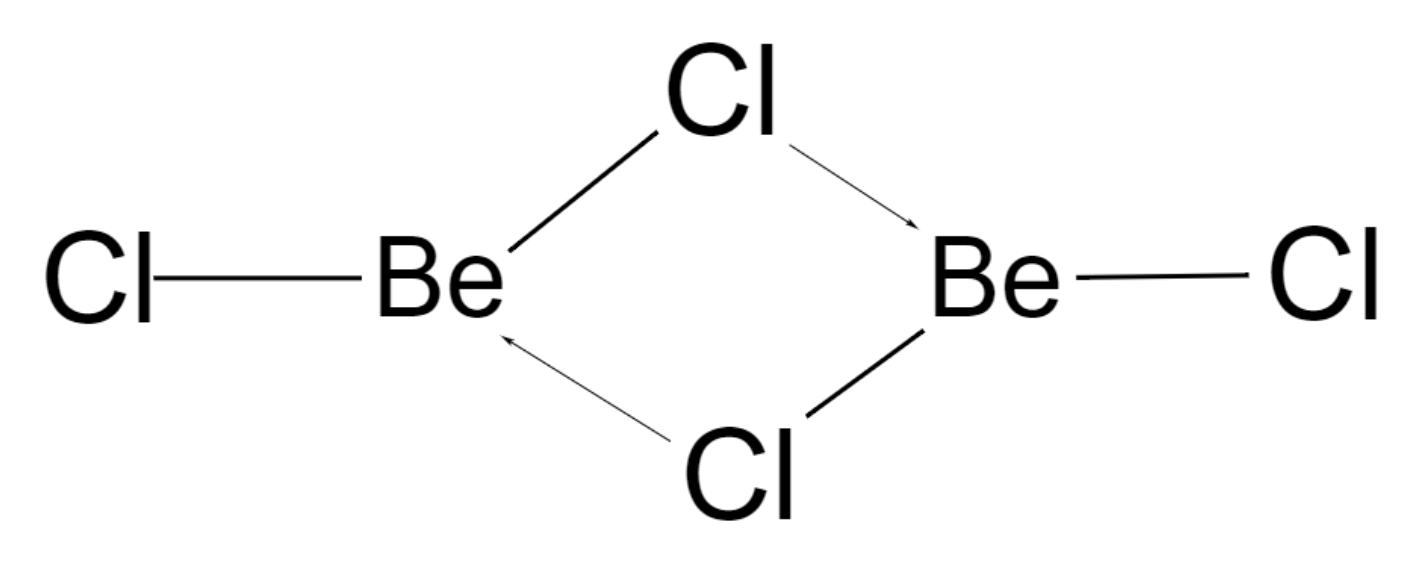
The structure of beryllium chloride in the solid-state and vapor phase, respectively, are:
(A) chain and dimeric
(B) chain and chain
(C) dimeric and dimeric
(D) dimeric and chain
Answer
448.2k+ views
Hint: In solid-state, beryllium chloride forms continuous coordinate bonds with surrounding chlorine atoms which is analogous to the structure of aluminium chloride. While in gaseous state two Be atoms are joined through a bridge of chlorine atoms. The bond formation takes place to complete the octet of atoms.
Complete answer:
Beryllium chloride is an inorganic compound. It is a colorless solid which can be dissolved in many polar solvents. Beryllium has 2 valence electrons and according to Valence bond theory, beryllium chloride has linear geometry in which the Be atom is sp-hybridized.

However, beryllium tends to form different structures in the solid and vapor phase to fulfill the number of electrons required to complete its octet.
In the vapor phase, it exists as a dimer in which two electrons in the valence bond of beryllium form covalent bonds with two chlorine atoms. But then two orbitals in beryllium remain unoccupied. So, it is called an electron-deficient compound.

On the other hand, in its solid-state, beryllium tends to build a polymeric chain in which two electrons in the valence bond of beryllium forms covalent bonds with two chlorine atoms. But then two orbitals in beryllium remain unoccupied. So, it forms a coordinate covalent bond with another two chlorine atoms which forms a bridge-like structure as shown below:

Hence, the correct answer is (A) chain and dimeric.
Note:
Beryllium chloride is hygroscopic in nature that means it readily absorbs moisture through adsorption and thus it exists as a tetrahydrate -
Complete answer:
Beryllium chloride is an inorganic compound. It is a colorless solid which can be dissolved in many polar solvents. Beryllium has 2 valence electrons and according to Valence bond theory, beryllium chloride has linear geometry in which the Be atom is sp-hybridized.

However, beryllium tends to form different structures in the solid and vapor phase to fulfill the number of electrons required to complete its octet.
In the vapor phase, it exists as a dimer in which two electrons in the valence bond of beryllium form covalent bonds with two chlorine atoms. But then two orbitals in beryllium remain unoccupied. So, it is called an electron-deficient compound.

On the other hand, in its solid-state, beryllium tends to build a polymeric chain in which two electrons in the valence bond of beryllium forms covalent bonds with two chlorine atoms. But then two orbitals in beryllium remain unoccupied. So, it forms a coordinate covalent bond with another two chlorine atoms which forms a bridge-like structure as shown below:

Hence, the correct answer is (A) chain and dimeric.
Note:
Beryllium chloride is hygroscopic in nature that means it readily absorbs moisture through adsorption and thus it exists as a tetrahydrate -
Recently Updated Pages
Master Class 11 Economics: Engaging Questions & Answers for Success

Master Class 11 Business Studies: Engaging Questions & Answers for Success

Master Class 11 Accountancy: Engaging Questions & Answers for Success

Master Class 11 English: Engaging Questions & Answers for Success

Master Class 11 Computer Science: Engaging Questions & Answers for Success

Master Class 11 Maths: Engaging Questions & Answers for Success

Trending doubts
Which one is a true fish A Jellyfish B Starfish C Dogfish class 11 biology CBSE

State and prove Bernoullis theorem class 11 physics CBSE

1 ton equals to A 100 kg B 1000 kg C 10 kg D 10000 class 11 physics CBSE

In which part of the body the blood is purified oxygenation class 11 biology CBSE

One Metric ton is equal to kg A 10000 B 1000 C 100 class 11 physics CBSE

Difference Between Prokaryotic Cells and Eukaryotic Cells




